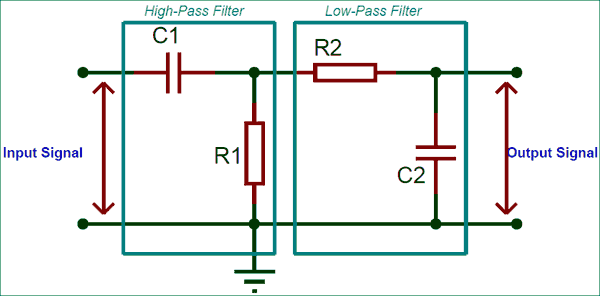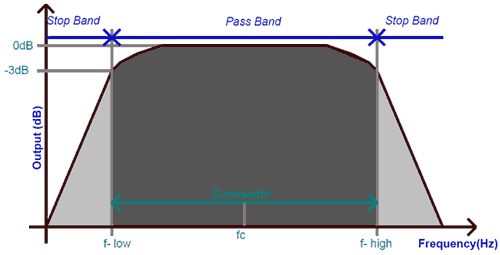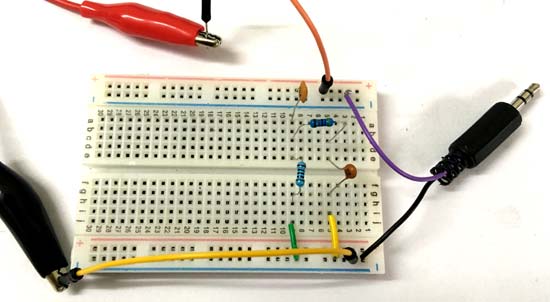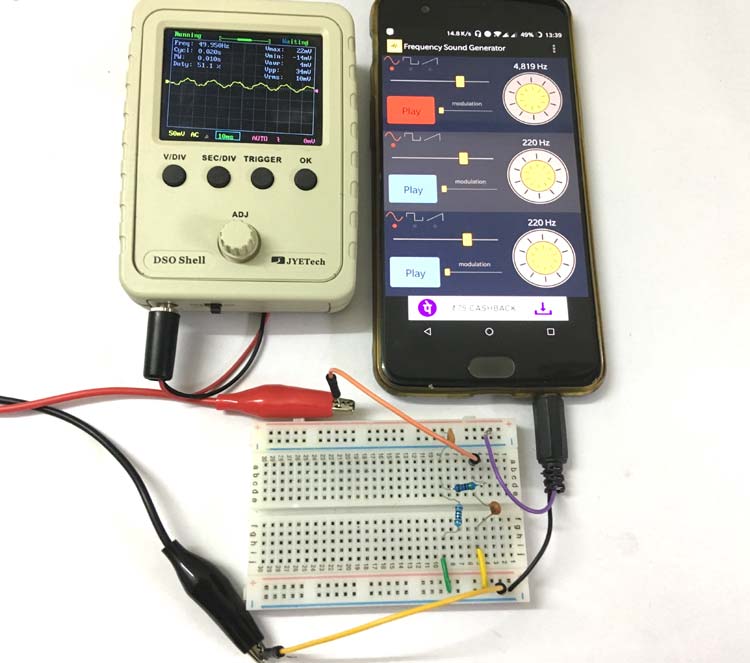Is A Wide Band Band Pass Filter A Krc Circuit
Every analog designer's nightmare would be to deal with noise in his circuit. When it comes to switching circuits or Audio amplifiers or frequency bespeak circuits in that location is a very good chance for the circuit to exist affected by noise signals. Out of the many ways to remove noise from a circuit, the most used one is called a Filter Circuit. As the proper noun suggests, this excursion will filter out the unwanted signals (noise) from the actual betoken. There are many types of filter circuit, but the about normally used and efficient one is the Ring Pass Filter which can be easily constructed using a pair of resistor and capacitors. So in this tutorial, we will larn about this Band Pass filter, the theory behind information technology and how information technology can be used in applied circuits.
What is a Bandpass filter?
A bandpass filter circuit/device is used to allow only a pre-defined set of frequencies to pass through information technology. Information technology will filter of all the frequency that is below the set value and above the set value. It is a combination of a high pass filter and a depression pass filter. A filter that allows only the frequencies that are college than it is called as loftier pass filter and the filter that allows the frequencies that are just lower than information technology is called as low pass filter. A bandpass filter can exist obtained by cascading both high and low pass filters. Information technology has a huge application in sound amplifier circuits and wireless transceivers where the speaker has to play only the desired set up of frequencies and ignore the rest.
There are 2 types of band pass filters. If the circuit involves some kind of external source of ability (active devices) like transistors etc. then the circuit is called as Agile bandpass filter and if the circuit does not involve whatever agile components and consists merely passive components like resistor, capacitor and inductor then the circuit is called as Passive bandpass filter. In this article we will discuss more than on the passive bandpass filter. Autonomously from this nomenclature, the other aspects on which the filter can be classified, will be briefed in this article.
Band Pass Filter Circuit
As told earlier we volition talk over the Passive Bandpass Filter which is constructed using resistor and capacitor. It is a combination of the high pass filter and low pass filter. A sample circuit diagram of a elementary passive Bandpass filter is shown below.

The get-go half of the circuit is a High-Pass filter which filters the low frequencies and allows only the frequency that is higher than the set high cutting-off frequency (fcLoftier). The value of this loftier cut-off frequency can be calculated using the formulae
fcLoftier = 1 / 2 π*R1*C1
The 2d half of the excursion is the Low-Pass filter circuit which filters the college frequencies and allows only the frequency that is lower than the set depression cut-off frequency (fcLOW). The value of low cutting-off frequency can be calculated using the formulae
fcLOW = i / two π*R2*C2
This type of filter circuit is called every bit iind social club filter because it has two resistors and two capacitors. A band pass filter could be a 2nd club filter or of higher order since a minimum of two resistor and capacitor is needed for proper functioning of the circuit. Now, when an input signal frequency is supplied to this filter it outputs a frequency which is college than fcLow and lower than fcHigh. In other words the output frequency tin can be given past fcLoftier- fcLOW , the frequency that lies in between this region is called as bandwidth. Hence the Bandwidth of the filter can be calculated past
Bandwidth = fcLoftier- fcLOW
Frequency Response of a Bandpass Filter
The Frequency response a.k.a Bode Plot bend for a 2nd order passive Bandpass filter is shown below.

The graph is plotted against the input frequency in the X-axis and the output in decibels in the Y-centrality. When the input frequency is less than the lower cut-off frequency (f-low) the output remains less than -3dB and when it exceeds that frequency, the output reaches the maximum and stays there until the frequency exceeds the higher cut-off frequency (f-high). The height at which the output gain stays maximum is called as the resonant frequency. Information technology is simply the geometric mean of the upper college cut-off frequency and the lower cut-off frequency. The formulae to calculate the same is given below
Resonant frequency (Fr) = √(f – low * f - high)
The altitude between the lower cut-off frequency and the higher cut-off frequency is called equally bandwidth. And so the input frequency will exist allowed to laissez passer through only if it is within limit of the bandwidth.
Applied Example of Band Laissez passer filters
Let us construct a simple band laissez passer filter to filter out a certain set of frequency and bank check how it actually works. The experimental set-up that I am using for this tutorial is shown below

As you can see the loftier pass filter is constructed using the capacitor 0.1uF (C1) and resistor 1K (R1). So the higher cut-off frequency for this circuit will exist
fcLoftier = i / 2π*R1*C1 = 1/(2*3.17*1*10^3*0.1*10^-6) =1577 Hz
The low pass filter is constructed using the capacitor 470pF (C2) and resistor 87K (R2). The lower cut-off frequency for this excursion tin be calculated every bit follows
fcDepression = 1 / 2π*R2*C2 = 1/(2*three.14*8.7*10^iii*470*10^-12) =7280 Hz
From the higher up calculations we tin can infer that the circuit will allows frequencies only in the range form 1577 Hz to 7280 HZ and anything less or more than this will exist filtered out by our bandpass filter. Let's check if the same is working by building the circuit on a breadboard. My test gear up-up looked something like this below

To test the circuit we need a office generator to generate signal frequency whose frequency tin exist controlled. Since I did not have one I decided to use my telephone which has an android awarding that would generate the required frequencies through my 3.5mm headphone jack. This point is and so given as the input frequency to the circuit using a jack as shown above.
To bank check the dependency of the application I used by oscilloscope to measure out the frequency of the input signal and plant that the generate frequency is liable. The below picture shows the awarding on my phone which generates about 4,819 Hz of input frequency and the scope continued to it displays the signal and measures a frequency of four.816 KHz which is perfect.

At present, we can connect the scope to the output bespeak of the circuit and vary the input frequency. The circuit will let all the frequency that is in between 1500 to 7000 to be displayed on the scope and the others will be filtered out or noisy. Also keep in mind that this circuit is simply for understanding purpose and hence is subjected to advancements before applying information technology in real terms. Also since the circuit is build over a breadboard the output signal might selection up some noise, place the capacitor as close as possible and reduce the length of its leads to reduce the problem. Promise you understood about Ring Laissez passer filters, if you have whatever question leave them in the comment below or use the forums.
Is A Wide Band Band Pass Filter A Krc Circuit,
Source: https://circuitdigest.com/electronic-circuits/band-pass-filter-circuit-diagram
Posted by: caldwellhanceseles.blogspot.com


0 Response to "Is A Wide Band Band Pass Filter A Krc Circuit"
Post a Comment